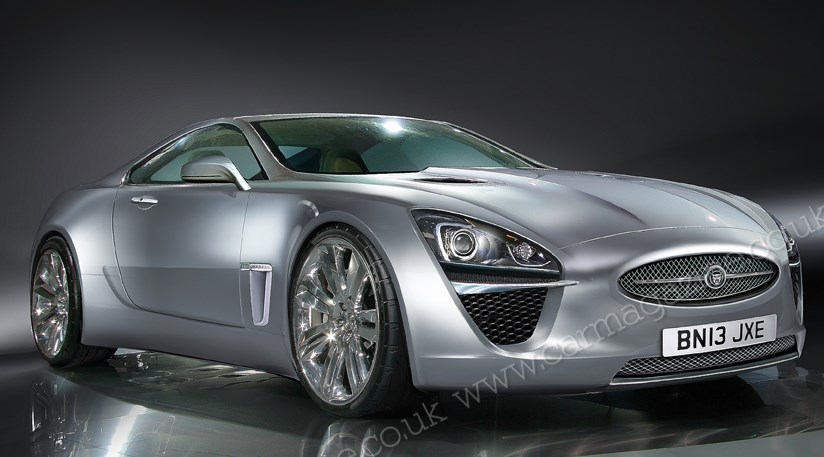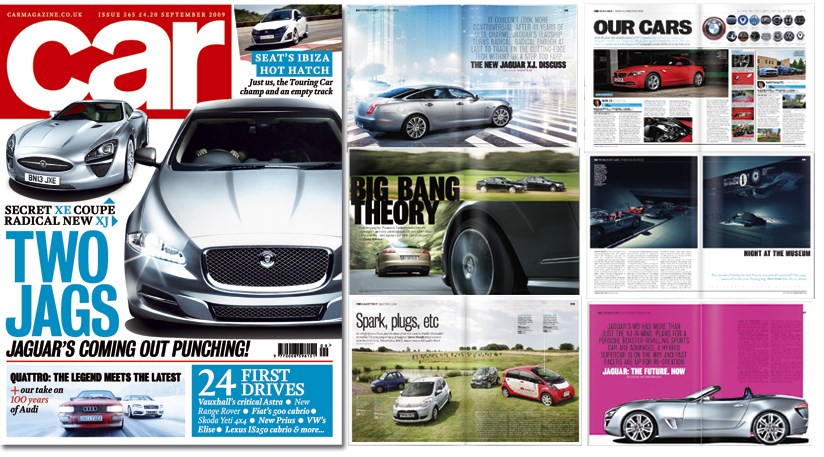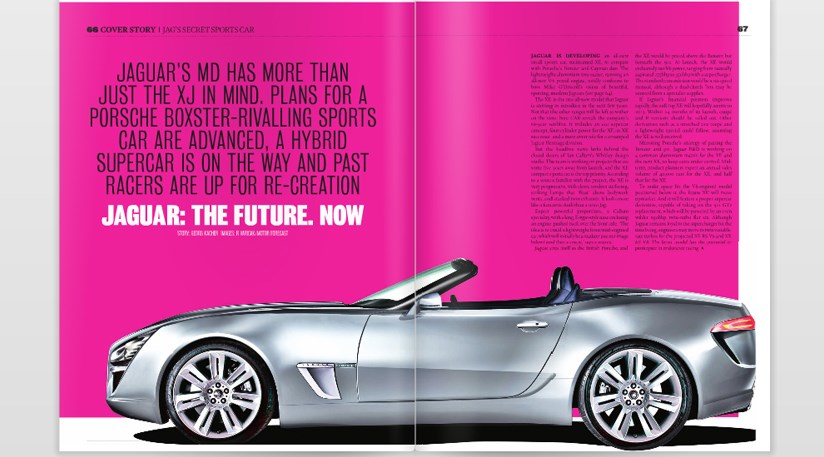O renascer de um mito. O coupé estará à venda já no primeiro trimestre de 2014 enquanto a versão roadster chegará no fim desse ano.

“A Jaguar agita o seu próprio passado. A vangloriada marca britânica veio com uma nova interpretação radical do XJ e os dias do X-type estão contados: em 2010, o novo XJ estará à venda, vindo completar uma gama de modelos intensos na marca. Como isso pretende que a marca seja mais desejável do que a BMW ou a Mercedes-Benz. Atrás dos holofotes está-se a trabalhar em diversos novos modelos. A mais elevada prioridade tem sido o XE: para a Jaguar denomina o carro de desportivo relativamente compacto que somente terá bloco V6 de injecção directa que se posicionará entre o SLK e o SL da Mercedes-Benz. A fonte da força (motor) a usar-se é relativamente compacto, mas o XE terá uma frente relativamente longa como o seu grande exemplo, o E-type. Não terá só o propósito de agradar à vista, mas também a potência atrás dos bancos da frente. Surgirá com uma versão roadster, mas depois seguir-se-á uma versão coupé.O uso intensivo do alumínio deve manter o peso dentro dos limites. O modelo de entrada poderá contar com a capacidade de 290cv, visto que para a variação turbocharged de 390cv surgir adiante. Com isso, o XE terá o mesmo volume de paixão que os modelos 911 da Porsche são capazes. Quem quiser um carro desportivo com motor V8 terá o XK, ou melhor ainda, o seu sucessor, que irá utilizar o mesmo quadro que o EX, mas com um tamanho maior.
A Jaguar está a fazer todos os esforços para que o XE esteja no mercado em 2012. Este novo carro desportivo é importante não só para a imagem, mas os ingleses pretendem também um relativamente grande número de vendas: falando de 40.000 unidades por ano. Uma meta ambiciosa, mas pelo dinheiro de um BMW Série 5 você vai chegar a um Jaguar XF. E em breve, pelo dinheiro de um Mercedes-Benz SLK 350 você poderá ir buscar o Jaguar XE.”
Fonte: autointernationaal;



“A transferência da Jaguar para o novo proprietário no ano passado havia muitos desassossegado clientes, concessionários e analistas da indústria, preocupados com o que poderia advir daí. Mas a proprietária Tata Motors até agora tem provado o seu compromisso para com a marca Jaguar. As últimas palavras de Ratan Tata reafirma a visão que a Tata tem para a Jaguar, e parece ser muito atractiva.
A actual recessão económica tem afectado duramente o globo em quase todos os sectores - indústria automóvel, em particular tem sentido isso de maneira difícil. A posição da Jaguar dentro da indústria é igualmente pobres - embora tenha um plano para sair por outro lado, e que inclui um enfoque sobre um novo roadster muitos pensam que vai ser chamado de XE.
O XE é esperado para estar disponível em carraçaria os roadster e coupé e será orientado essencialmente para os modelos Porsches Boxster e o Cayman, embora vários modelos Lotus também estejam na mira do XE.
Segundo os últimos relatórios, a XE estará disponível em 2013 e estará em algum lugar entre o preço actual do Porsche Cayman e 911. Será construído sobre uma nova plataforma de alumínio que acabará por constituir a base da próxima geração XK, XF e até mesmo através do XJ 2015 e para além desta. Vai ser declaradamente uma matriz comum de alumínio, com a unidade do motor à frente enviando a força motriz para as rodas traseiras.
Quanto ao propulsor do XE, esperamos que nas versões disponíveis seja usado um V6 a gasolina naturalmente, aspirado, e sobrealimentado. A potência na gama deverá ir de cerca de 275 cavalos no modelo básico e correr direito até 350 cavalos de força. Relatórios anteriores sugeriram que uma variante híbrida pode até ser lançada embora as hipóteses para este modelo serem poucas.”
Fonte: carmagazine
“É o carro desportivo que todos os fãs da Jaguar têm desesperado para ver! Este é o novo rival para a Porsche Boxster do “grande felino” - um compacto conversível de dois lugares, que promete desempenho e estilo a um preço acessível.
Evocando lembranças do lendário C-Type, que irá liderar uma nova onda de automobilistas focados nas máquinas, levando a empresa por desconhecidos - mas com muito potencial - territórios. O mercado desportivo compacto é enorme e, assim como o Boxster, inclui como rivais o Audi TT, BMW Z4, Nissan 370Z, Mercedes SLK: Jaguar precisa de uma fatia da acção.
Baseando-se em seguir fortemente a gama XK, o novato terá características marcantes e um estilo de chassis virado para tracção traseira. Com um preço estimado abaixo das 40.000 libras, será uma verdadeira receita para o sucesso.
Ratan Tata, o chefe do gigante indiano Tata Motors, proprietária da Jaguar, Land Rover, não tem feito segredo do seu desejo para a Jaguar ampliar a sua linha de carros desportivos - e isso pode ser fundamental para assegurar o futuro da empresa. Graças a informações privilegiadas, podemos-lhe dar a melhor visão ainda de como poderá ser a aparência da máquina.
É claro que o novo modelo evolui sugestões do XF, como a grelha em negrito, os faróis de LED aguçados e capota eléctrica, tornando-o mais agressivo e desportivo. Uma acentuada inclinação do pára-brisas e traseira musculada são mais destaques. O look é completado por um “pert” traseiro com ópticas traseiras afiladas, um friso cromado estilo XF e saídas de escape cromados integradas. Em suma, o veículo tem a forma tradicional do roadster britânico e torna-o completamente moderno.
Como com o XK, o novo carro desportivo iria usar um monobloco em alumínio com painéis estruturados para maximizar a economia de peso e rigidez estrutural. Um dois lugares, teria a característica de um tecto de lona dobrável operado electricamente, para ser arrumada atrás das cabeças dos ocupantes.
Debaixo do capot, haverá uma ampla gama de motores de todas as utilizadas a partir do XF, com de nível de entrada de 3.0 diesel de 240cv versão V6 e um porta-estandarte de 380cv 5.0 V8. Há também espaço para oferecer mais do XF o 3 litros biturbo diesel, que se orgulha de 275cv. Todos os modelos estarão equipados com a excelente caixa automática Jaguar de seis velocidades, completada com patilhas no volante.
Com um chassis leve, até mesmo o 3 litros V6 de nível de entrada será muito rápido, ostentando a 0-100 em cerca de sete segundos. A versão 5 litros V8 poderia reduzir dois segundos de sprint e aceleração, a 250 km/h.
Como o XF tem mostrado, engenheiros talentosos da “Jag” podem produzir uma berlina de apontamentos de um carro desportivo, mas oferece uma boleia “cosseting”. Então, fazer um mais puro roadster agradável de conduzir deve ser uma tarefa que irão apreciar. Mas, enquanto o carro irá ser ágil, dinâmico e desportivo de conduzir, ele também promete ser extremamente confortável.
Claro, a empresa não está isenta de problemas: a Tata, está actualmente a tentar obter apoio financeiro do Governo do Reino Unido. E isso significa que o novo XJ berlina mais o próximo XF Estate (carrinha), bem como uma versão conversível deste carro serão as suas prioridades por agora.
Este rival do Boxster, juntamente com um substituto para o lendário E-Type e um supercarro de estilo Audi R8, estão na prancheta, no entanto, chegarão em 2012, no mínimo.”
Ler mais: http://www.autoexpress.co.uk/news/autoexpressnews/236290/jaguars_new_ctype_on_the_prowl.html#ixzz0P0GeDvf5
Fonte: Autoexpress


Renders mais recentes:



“A Jaguar agita o seu próprio passado. A vangloriada marca britânica veio com uma nova interpretação radical do XJ e os dias do X-type estão contados: em 2010, o novo XJ estará à venda, vindo completar uma gama de modelos intensos na marca. Como isso pretende que a marca seja mais desejável do que a BMW ou a Mercedes-Benz. Atrás dos holofotes está-se a trabalhar em diversos novos modelos. A mais elevada prioridade tem sido o XE: para a Jaguar denomina o carro de desportivo relativamente compacto que somente terá bloco V6 de injecção directa que se posicionará entre o SLK e o SL da Mercedes-Benz. A fonte da força (motor) a usar-se é relativamente compacto, mas o XE terá uma frente relativamente longa como o seu grande exemplo, o E-type. Não terá só o propósito de agradar à vista, mas também a potência atrás dos bancos da frente. Surgirá com uma versão roadster, mas depois seguir-se-á uma versão coupé.O uso intensivo do alumínio deve manter o peso dentro dos limites. O modelo de entrada poderá contar com a capacidade de 290cv, visto que para a variação turbocharged de 390cv surgir adiante. Com isso, o XE terá o mesmo volume de paixão que os modelos 911 da Porsche são capazes. Quem quiser um carro desportivo com motor V8 terá o XK, ou melhor ainda, o seu sucessor, que irá utilizar o mesmo quadro que o EX, mas com um tamanho maior.
A Jaguar está a fazer todos os esforços para que o XE esteja no mercado em 2012. Este novo carro desportivo é importante não só para a imagem, mas os ingleses pretendem também um relativamente grande número de vendas: falando de 40.000 unidades por ano. Uma meta ambiciosa, mas pelo dinheiro de um BMW Série 5 você vai chegar a um Jaguar XF. E em breve, pelo dinheiro de um Mercedes-Benz SLK 350 você poderá ir buscar o Jaguar XE.”
Fonte: autointernationaal;



“A transferência da Jaguar para o novo proprietário no ano passado havia muitos desassossegado clientes, concessionários e analistas da indústria, preocupados com o que poderia advir daí. Mas a proprietária Tata Motors até agora tem provado o seu compromisso para com a marca Jaguar. As últimas palavras de Ratan Tata reafirma a visão que a Tata tem para a Jaguar, e parece ser muito atractiva.
A actual recessão económica tem afectado duramente o globo em quase todos os sectores - indústria automóvel, em particular tem sentido isso de maneira difícil. A posição da Jaguar dentro da indústria é igualmente pobres - embora tenha um plano para sair por outro lado, e que inclui um enfoque sobre um novo roadster muitos pensam que vai ser chamado de XE.
O XE é esperado para estar disponível em carraçaria os roadster e coupé e será orientado essencialmente para os modelos Porsches Boxster e o Cayman, embora vários modelos Lotus também estejam na mira do XE.
Segundo os últimos relatórios, a XE estará disponível em 2013 e estará em algum lugar entre o preço actual do Porsche Cayman e 911. Será construído sobre uma nova plataforma de alumínio que acabará por constituir a base da próxima geração XK, XF e até mesmo através do XJ 2015 e para além desta. Vai ser declaradamente uma matriz comum de alumínio, com a unidade do motor à frente enviando a força motriz para as rodas traseiras.
Quanto ao propulsor do XE, esperamos que nas versões disponíveis seja usado um V6 a gasolina naturalmente, aspirado, e sobrealimentado. A potência na gama deverá ir de cerca de 275 cavalos no modelo básico e correr direito até 350 cavalos de força. Relatórios anteriores sugeriram que uma variante híbrida pode até ser lançada embora as hipóteses para este modelo serem poucas.”
Fonte: carmagazine
“É o carro desportivo que todos os fãs da Jaguar têm desesperado para ver! Este é o novo rival para a Porsche Boxster do “grande felino” - um compacto conversível de dois lugares, que promete desempenho e estilo a um preço acessível.
Evocando lembranças do lendário C-Type, que irá liderar uma nova onda de automobilistas focados nas máquinas, levando a empresa por desconhecidos - mas com muito potencial - territórios. O mercado desportivo compacto é enorme e, assim como o Boxster, inclui como rivais o Audi TT, BMW Z4, Nissan 370Z, Mercedes SLK: Jaguar precisa de uma fatia da acção.
Baseando-se em seguir fortemente a gama XK, o novato terá características marcantes e um estilo de chassis virado para tracção traseira. Com um preço estimado abaixo das 40.000 libras, será uma verdadeira receita para o sucesso.
Ratan Tata, o chefe do gigante indiano Tata Motors, proprietária da Jaguar, Land Rover, não tem feito segredo do seu desejo para a Jaguar ampliar a sua linha de carros desportivos - e isso pode ser fundamental para assegurar o futuro da empresa. Graças a informações privilegiadas, podemos-lhe dar a melhor visão ainda de como poderá ser a aparência da máquina.
É claro que o novo modelo evolui sugestões do XF, como a grelha em negrito, os faróis de LED aguçados e capota eléctrica, tornando-o mais agressivo e desportivo. Uma acentuada inclinação do pára-brisas e traseira musculada são mais destaques. O look é completado por um “pert” traseiro com ópticas traseiras afiladas, um friso cromado estilo XF e saídas de escape cromados integradas. Em suma, o veículo tem a forma tradicional do roadster britânico e torna-o completamente moderno.
Como com o XK, o novo carro desportivo iria usar um monobloco em alumínio com painéis estruturados para maximizar a economia de peso e rigidez estrutural. Um dois lugares, teria a característica de um tecto de lona dobrável operado electricamente, para ser arrumada atrás das cabeças dos ocupantes.
Debaixo do capot, haverá uma ampla gama de motores de todas as utilizadas a partir do XF, com de nível de entrada de 3.0 diesel de 240cv versão V6 e um porta-estandarte de 380cv 5.0 V8. Há também espaço para oferecer mais do XF o 3 litros biturbo diesel, que se orgulha de 275cv. Todos os modelos estarão equipados com a excelente caixa automática Jaguar de seis velocidades, completada com patilhas no volante.
Com um chassis leve, até mesmo o 3 litros V6 de nível de entrada será muito rápido, ostentando a 0-100 em cerca de sete segundos. A versão 5 litros V8 poderia reduzir dois segundos de sprint e aceleração, a 250 km/h.
Como o XF tem mostrado, engenheiros talentosos da “Jag” podem produzir uma berlina de apontamentos de um carro desportivo, mas oferece uma boleia “cosseting”. Então, fazer um mais puro roadster agradável de conduzir deve ser uma tarefa que irão apreciar. Mas, enquanto o carro irá ser ágil, dinâmico e desportivo de conduzir, ele também promete ser extremamente confortável.
Claro, a empresa não está isenta de problemas: a Tata, está actualmente a tentar obter apoio financeiro do Governo do Reino Unido. E isso significa que o novo XJ berlina mais o próximo XF Estate (carrinha), bem como uma versão conversível deste carro serão as suas prioridades por agora.
Este rival do Boxster, juntamente com um substituto para o lendário E-Type e um supercarro de estilo Audi R8, estão na prancheta, no entanto, chegarão em 2012, no mínimo.”
Ler mais: http://www.autoexpress.co.uk/news/autoexpressnews/236290/jaguars_new_ctype_on_the_prowl.html#ixzz0P0GeDvf5
Fonte: Autoexpress


Renders mais recentes:











































Comentário